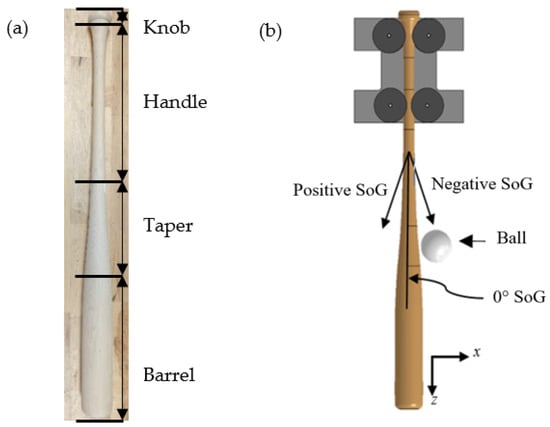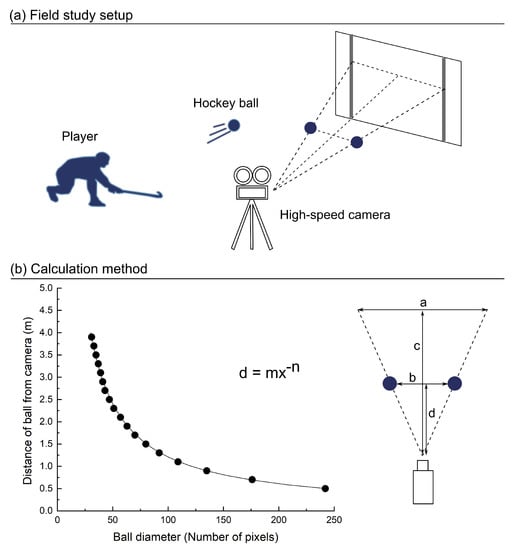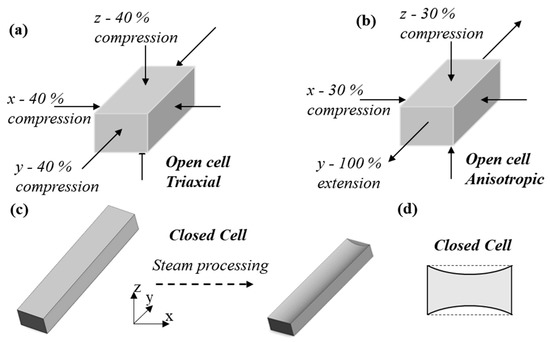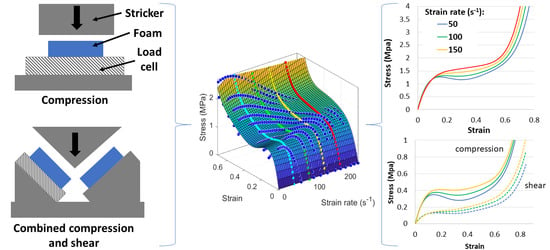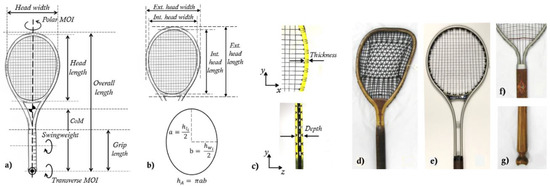Sports Equipment and Materials
Share This Topical Collection
Editors
 Dr. Oliver Duncan
Dr. Oliver Duncan
 Dr. Oliver Duncan
Dr. Oliver Duncan
E-Mail
Website
Collection Editor
Materials and Engineering Research Institute, Sheffield Hallam University, Sheffield S1 1WB, UK
Interests: material testing; performance modelling; auxetic materials; negative stiffness materials; mechanical engineering
 Dr. Thomas Allen
Dr. Thomas Allen
 Dr. Thomas Allen
Dr. Thomas Allen
E-Mail
Website
Collection Editor
Sports Engineering Research Team, Manchester Metropolitan University, Manchester M15 6BH, UK
Interests: sports engineering; finite element analysis; material characterization; experimental mechanics; sports injury prevention; sports equipment design; auxetic materials
Special Issues, Collections and Topics in MDPI journals
Topical Collection Information
Dear Colleagues,
The world of sport is dominated by materials; they are a key component of every piece of sports equipment; every modern playing surface; and of clothing, footwear, and safety devices. History has shown that advances in materials have usually gone hand in hand with noticeable performance improvements. Any change or introduction of new materials into elite sport must be closely governed so as not to cause too-drastic of a performance increase and/or be detrimental to the spectacle of the sport. Materials are also making sport and recreational activities safer by improving the performance of safety devices and personal protective equipment (PPE). Along with all of these developments, new manufacturing processes and the use of new types of materials have brought down the costs of equipment, making certain sports more accessible to more people.
This Topical Collection on “Sports Equipment and Materials" is dedicated to recent advances in the research and development of the materials, equipment design, surfaces, apparel, and the human body in relation to sport and physical activity. We invite you to submit research articles or reviews on the latest research work in these areas, with emphasis on applications in all areas of science and engineering.
Dr. Leon Foster
Dr. Oliver Duncan
Dr. Thomas Allen
Dr. James Webster
Prof. Andy Alderson
Guest Editors
Manuscript Submission Information
Manuscripts should be submitted online at www.mdpi.com by registering and logging in to this website. Once you are registered, click here to go to the submission form. Manuscripts can be submitted until the deadline. All submissions that pass pre-check are peer-reviewed. Accepted papers will be published continuously in the journal (as soon as accepted) and will be listed together on the collection website. Research articles, review articles as well as short communications are invited. For planned papers, a title and short abstract (about 100 words) can be sent to the Editorial Office for announcement on this website.
Submitted manuscripts should not have been published previously, nor be under consideration for publication elsewhere (except conference proceedings papers). All manuscripts are thoroughly refereed through a single-blind peer-review process. A guide for authors and other relevant information for submission of manuscripts is available on the Instructions for Authors page. Applied Sciences is an international peer-reviewed open access semimonthly journal published by MDPI.
Please visit the Instructions for Authors page before submitting a manuscript.
The Article Processing Charge (APC) for publication in this open access journal is 2400 CHF (Swiss Francs).
Submitted papers should be well formatted and use good English. Authors may use MDPI's
English editing service prior to publication or during author revisions.
Keywords
- Instrumentation
- Testing
- Performance
- Protection
- Modelling
- Finite element analysis
- Composite
- Polymer
- Equipment
- Impact
Published Papers (5 papers)
Open AccessArticle
An Investigation of Wood Baseball Bat Durability as a Function of Bat Profile and Slope of Grain Using Finite Element Modeling and Statistical Analysis
by
Blake Campshure, Patrick Drane and James A. Sherwood
Viewed by 2867
Abstract
To counter a perceived increase in multi-piece fracturing of wood baseball bats, Major League Baseball implemented standards to regulate the quality of wood used in the making of professional-grade baseball bats. These specifications included a minimum density as a function of wood species
[...] Read more.
To counter a perceived increase in multi-piece fracturing of wood baseball bats, Major League Baseball implemented standards to regulate the quality of wood used in the making of professional-grade baseball bats. These specifications included a minimum density as a function of wood species and a standard related to slope of grain (SoG). Following the implementation of these specifications in 2008, there was a 65% reduction in the multi-piece failure rate. It is hypothesized that a further reduction in the breakage rate can be realized through the implementation of regulations on allowable bat profiles. In the current work, a parametric study was conducted to develop a quantitative understanding of the relationship between bat durability (i.e., resistance to breaking), SoG, and bat profile, thereby obtaining data to support or refute the hypothesis. Finite element models of the bat/ball impact of four different popular bat profiles were created using LS-DYNA software. Similarities and differences between bat profiles impacted at two relatively vulnerable axial locations are presented and discussed. Lastly, the respective bat durabilities for all of the profiles were compared using a probability analysis that considers the SoG, impact location, impact velocity, and it predicts an in-service bat durability.
Full article
►▼
Show Figures
Open AccessArticle
A Novel Method for the Mechanical Testing of Sports Mouthguards
by
Thomas Goldberg, Maria Lißner, David Townsend, Nik Petrinic and Jeroen Bergmann
Cited by 1 | Viewed by 2791
Abstract
Current mouthguard test methods require improvement, as the impact energies during traditional testing do not reflect the higher energy that can be observed in actual use during sport. A new data set of ball speeds experienced during the sport of field hockey was
[...] Read more.
Current mouthguard test methods require improvement, as the impact energies during traditional testing do not reflect the higher energy that can be observed in actual use during sport. A new data set of ball speeds experienced during the sport of field hockey was obtained. These ball speeds have then been used to estimate impact energies. This information was used to subsequently develop a new test method consisting of a high-speed camera and drop tower. Observations show an increase in energy experienced by the mouthguard for higher-impact energies. The work carried out showed that current testing methods for sports mouthguards use lower-energy impacts than experienced during the sport of field hockey. The new method that is proposed allows for a more realistic representation of real-world impacts.
Full article
►▼
Show Figures
Open AccessArticle
Effect of Compressive Strain Rate on Auxetic Foam
by
Olly Duncan, Nicolas Bailly, Tom Allen, Yvan Petit, Eric Wagnac and Andrew Alderson
Cited by 11 | Viewed by 3487
Abstract
Auxetic foams have previously been shown to have benefits including higher indentation resistance than their conventional counterparts, due to their negative Poisson’s ratio, making them better at resisting penetration by concentrated loads. The Poisson’s ratio and Young’s modulus of auxetic open cell foams
[...] Read more.
Auxetic foams have previously been shown to have benefits including higher indentation resistance than their conventional counterparts, due to their negative Poisson’s ratio, making them better at resisting penetration by concentrated loads. The Poisson’s ratio and Young’s modulus of auxetic open cell foams have rarely been measured at the high compressive strain rates typical during impacts of energy absorbing material in sporting protective equipment. Auxetic closed cell foams are less common than their open cell counterparts, and only their quasi-static characteristics have been previously reported. It is, therefore, unclear how the Poisson’s ratio of auxetic foam, and associated benefits such as increased indentation resistance shown at low strain rates, would transfer to the high strain rates expected under impact. The aim of this study was to measure the effect of strain rate on the stiffness and Poisson’s ratio of auxetic and conventional foam. Auxetic open cell and closed cell polymer foams were fabricated, then compression tested to ~80% strain at applied rates up to 200 s
−1, with Poisson’s ratios obtained from optical full-field strain mapping. Open cell foam quasi-static Poisson’s ratios ranged from −2.0 to 0.4, with a narrower range of −0.1 to 0.3 for closed cell foam. Poisson’s ratios of auxetic foams approximately halved in magnitude between the minimum and maximum strain rates. Open cell foam quasi-static Young’s moduli were between 0.02 and 0.09 MPa, whereas closed cell foams Young’s moduli were ~1 MPa, which is like foam in protective equipment. The Young’s moduli of the auxetic foams approximately doubled at the highest applied strain rate of 200 s
−1.
Full article
►▼
Show Figures
Open AccessFeature PaperArticle
Strain Rate Dependent Behavior of Vinyl Nitrile Helmet Foam in Compression and Combined Compression and Shear
by
Nicolas Bailly, Yvan Petit, Jean-Michel Desrosier, Olivier Laperriere, Simon Langlois and Eric Wagnac
Cited by 13 | Viewed by 2859
Abstract
Vinyl nitrile foams are polymeric closed-cell foam commonly used for energy absorption in helmets. However, their impact behavior has never been described in isolation. This study aims to characterize the strain rate dependent behavior of three VN foams in compression and combined compression
[...] Read more.
Vinyl nitrile foams are polymeric closed-cell foam commonly used for energy absorption in helmets. However, their impact behavior has never been described in isolation. This study aims to characterize the strain rate dependent behavior of three VN foams in compression and combined compression and shear. Vinyl nitrile samples of density 97.5, 125, and 183 kg/m
3 were submitted to quasi-static compression (0.01 s
−1) and impacts in compression and combined compression and shear (loading direction of 45°). For impacts, a drop test rig was used, and a method was developed to account for strain rate variation during impactor deceleration. Young’s modulus and stress at plateau were correlated with foam density in both compression and combined loading. Vinyl nitrile foams were strain rate dependent: The absorbed energy at the onset of densification was two to four times higher at 100 s
−1 than at 0.01 s
−1. In combined loading, the compressive stress at yield was reduced by 43% at a high strain rate. Compared to expanded polypropylene, vinyl nitrile foams transmitted less stress at the onset of densification for equivalent absorbed energy and presented a larger ratio between the compression and shear stresses in combined loading (0.37 at yield). This larger ratio between the compression and shear stresses might explain why vinyl nitrile helmet liners are thought to be better at reducing head rotational acceleration than expanded polypropylene helmet liners.
Full article
►▼
Show Figures
Open AccessArticle
Materials Have Driven the Historical Development of the Tennis Racket
by
Luca Taraborrelli, Robyn Grant, Matthew Sullivan, Simon Choppin, James Spurr, Steve Haake and Tom Allen
Cited by 7 | Viewed by 20359
Abstract
The tennis racket has developed since the origins of Lawn Tennis in the 1870s. This study investigated how the tennis racket developed from 1874 to 2017, using measurements and material classifications for 525 samples. Racket measurements covered geometric, inertial and dynamic properties, and
[...] Read more.
The tennis racket has developed since the origins of Lawn Tennis in the 1870s. This study investigated how the tennis racket developed from 1874 to 2017, using measurements and material classifications for 525 samples. Racket measurements covered geometric, inertial and dynamic properties, and the number of strings. Rackets predating 1970 were mainly wooden, and typically characterised by head areas below 0.05 m
2, masses over 350 g and natural frequencies below 120 Hz. Rackets from the 1970s were made from wood, metal and fibre–polymer composites, with most postdating 1980 made from fibre–polymer composites with a larger head, lower mass and higher natural frequency than their predecessors. Principal component analysis was used to reduce the dimensionality of the number of variables. Principal component one (PCA1) accounted for 35% of the variance in the measured racket properties, and was found to be significantly affected by material. Head width was best correlated with principal component one (r = 0.897, p < 0.001), followed by head length (r = 0.841, p < 0.001) and natural frequency (r = 0.813, p < 0.001). Early rackets were constrained by the limitations of wood, and the move to composites, which began in the 1970s, allowed this observed increase in head size and natural frequency. As material development has been a major driver of racket design in the past, we propose that new materials and manufacturing techniques, like additively manufactured composites, could further improve the tennis racket. The measurement techniques described here can be used to monitor developments in racket design.
Full article
►▼
Show Figures






